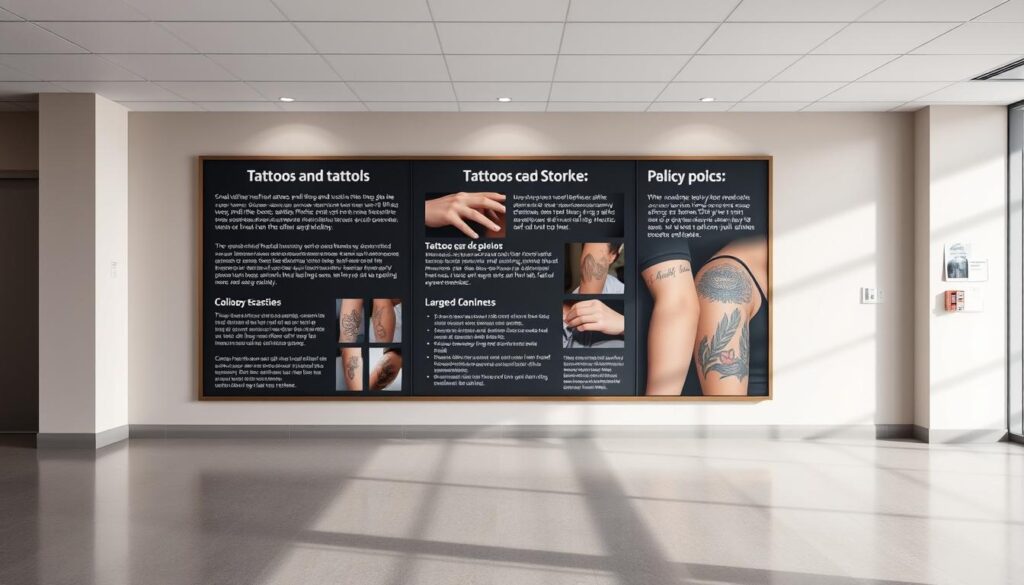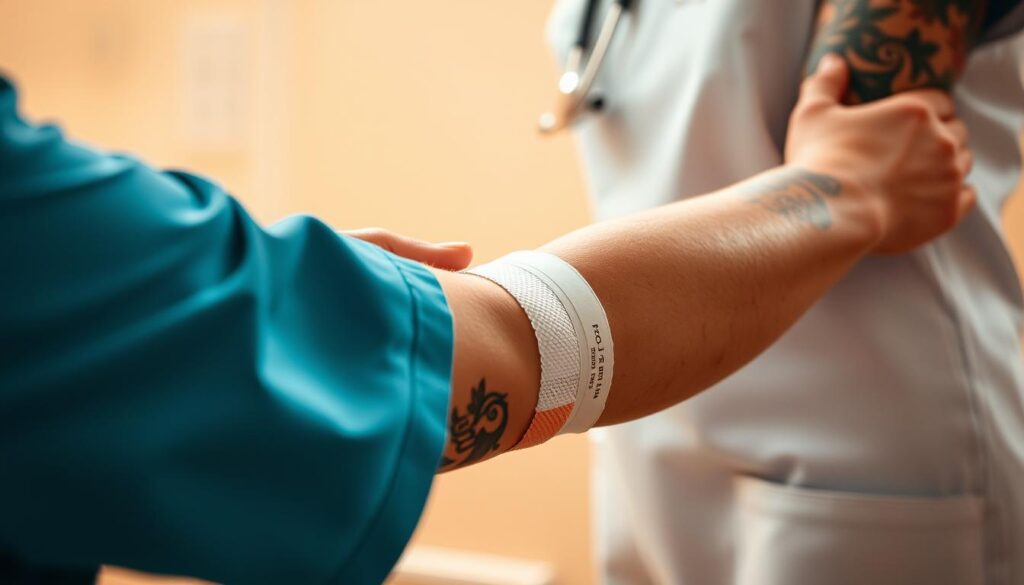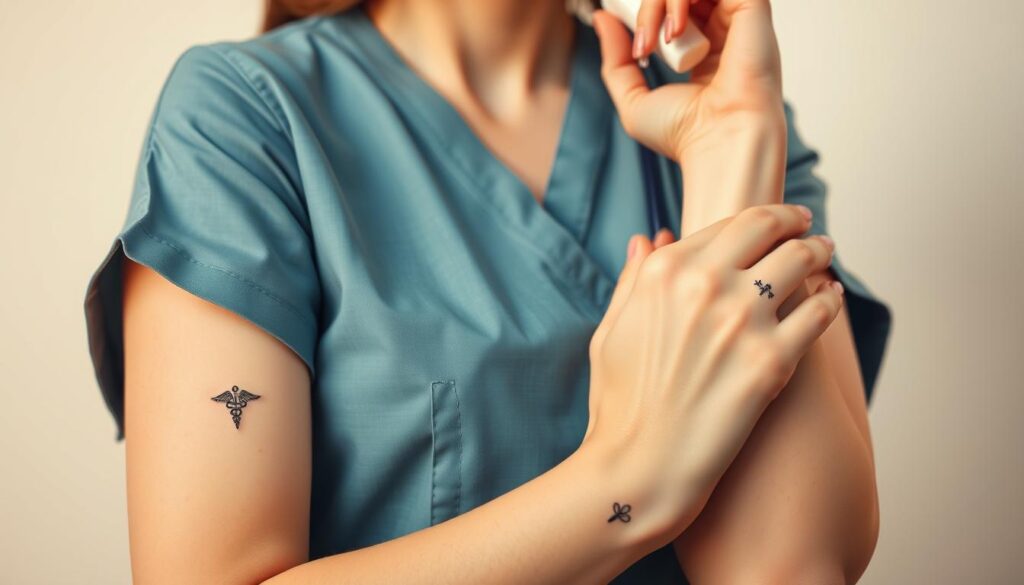
What if your passion for self-expression through body art could coexist with a thriving healthcare career? With 32% of Americans sporting at least one tattoo, this question matters now more than ever for those entering or advancing in nursing.
The American Nursing Association doesn’t restrict body modifications, but workplace rules vary widely. While 76% of employers say they’re open to hiring people with visible ink, some hospitals still require coverage during shifts.
Your journey depends on factors like facility type and patient demographics. Urban urgent care centers often embrace individuality more than conservative rural clinics. Pediatric units sometimes enforce stricter guidelines compared to adult emergency departments.
This guide unpacks how location, employer preferences, and cultural shifts shape opportunities for healthcare professionals with body art. You’ll learn practical strategies to navigate policies while maintaining personal style.
Key Takeaways
- Body art remains legal for nursing professionals nationwide
- 1 in 3 Americans has tattoos, reflecting shifting social norms
- Employers set individual dress code requirements
- Acceptance often depends on workplace culture and patient populations
- Healthcare industry attitudes continue evolving toward inclusivity
Introduction to Tattoos in the Nursing Profession

As society embraces individuality, healthcare professionals are redefining traditional appearance standards. Over 32% of Americans now wear body art, reflecting a cultural shift that’s reaching hospital corridors and clinics.
Why Body Art Gains Momentum in Medical Settings
Younger generations view tattoos as personal narratives rather than rebellion. A 2023 study found 68% of patients under 40 feel body art doesn’t affect care quality. This mindset pushes healthcare leaders to rethink outdated policies.
Facilities now balance patient comfort with staff authenticity. Urban hospitals often adopt progressive guidelines, while rural centers may request discreet placements. Pediatric units sometimes enforce stricter rules than adult ICUs.
When Personal Style Meets Patient Care
Healthcare institutions prioritize trust-building. While 54% of seniors associate visible ink with unprofessionalism, millennials see it as relatable. Forward-thinking organizations focus on competencies over appearances.
| Factor | Traditional Approach | Modern Shift |
|---|---|---|
| Patient Demographics | Full coverage required | Case-by-case decisions |
| Workplace Culture | Strict dress codes | Values-driven flexibility |
| Art Content | Complete prohibition | Offensive imagery restrictions |
This evolution mirrors broader workplace trends. As one hospital administrator notes: “Our focus shifted from policing skin to measuring compassion and clinical skills.”
Can Nurses Have Tattoos? Understanding Workplace Regulations

How do medical institutions balance staff expression with patient trust? Workplace standards for body art vary dramatically across organizations. Unlike universal clinical protocols, tattoo policies get shaped by local values and community expectations.
The Role of Healthcare Facility Policies
Healthcare facilities craft their rules based on four key elements. Professional image concerns lead many to request coverage of visible body art during shifts. Patient comfort also guides decisions – hospitals serving older populations often enforce stricter standards than those catering to younger demographics.
Cultural sensitivity plays a major role in diverse communities. Organizations in multicultural areas frequently restrict symbols that might conflict with local traditions. Content restrictions universally apply, with 89% of facilities prohibiting violent or explicit imagery regardless of placement.
Smart professionals research workplace policies before interviews. Review employee handbooks thoroughly and consider asking HR about tattoo policy specifics during onboarding. Observing current staff during facility tours can reveal unspoken expectations about self-expression.
Common Tattoo Policies in Healthcare Facilities

Healthcare institutions approach body art through four distinct policy frameworks. These range from full coverage mandates to complete acceptance, reflecting evolving workplace norms. Understanding these guidelines helps professionals align their choices with employer expectations.
Cover-Up Requirements and Dress Code Guidelines
Many hospitals require concealing body art during shifts. Long sleeves, compression arm sleeves, and specialized makeup rank as popular solutions. Some institutions permit small wrist or neck designs if they’re non-distracting.
Dress code rules often specify:
- No violent or explicit imagery
- Maximum tattoo size limits (typically 2-3 inches)
- Discreet placement below collarbone or above elbows
Variations Across Urban and Conservative Settings
Urban teaching hospitals frequently adopt progressive standards. A Chicago medical center’s policy states: “Artistic expression shouldn’t hinder quality care delivery.” Contrast this with rural clinics where 63% require full coverage regardless of design.
| Policy Type | Common Locations | Key Features |
|---|---|---|
| Full Coverage | Religious hospitals | Bandages/makeup required |
| Partial Allowance | University hospitals | Palm-sized designs permitted |
| No Restrictions | Urban ERs | Only offensive content banned |
Interestingly, while 40% of Americans question workplace appropriateness, only 4% of inked staff report actual discrimination. This gap highlights shifting attitudes in modern healthcare facilities.
Impact of Visible Tattoos on Your Nursing Career

Your career trajectory in healthcare might be influenced by visible ink in unexpected ways. While skills remain paramount, first impressions during interviews often set the tone for professional relationships. 72% of hiring managers in a 2024 survey noted appearance influences initial assessments, though 68% reconsidered after evaluating clinical competencies.
Effect on Job Interviews and Career Advancement
Conservative facilities might request covering body art during interviews. One hospital administrator shared: “We prioritize ability, but patient comfort guides our dress code.” Leadership roles sometimes demand stricter adherence to traditional appearance standards, though urban teaching hospitals increasingly value authenticity over uniformity.
Patient Perceptions and Professional Image
Age demographics shape reactions significantly. While 55% of seniors prefer minimal visible body art, 83% of millennials report neutrality. Pediatric units often enforce coverage policies, whereas emergency departments focus on urgent care needs over aesthetics.
| Specialty | Acceptance Level | Common Policies |
|---|---|---|
| Emergency Care | High | Content restrictions only |
| Pediatrics | Moderate | Coverage required |
| Leadership Roles | Variable | Case-by-case decisions |
Geographic location plays a key role. Metropolitan areas show 40% higher acceptance rates than rural regions. With staffing shortages, many facilities now prioritize qualifications over appearance, creating new opportunities for skilled professionals.
Acceptable Tattoo Designs and Placement for Nurses

Balancing self-expression with professional expectations starts with smart design choices. Healthcare facilities typically welcome body art that complements clinical environments rather than distracts from care delivery.
Choosing Non-Offensive and Discreet Designs
Neutral imagery creates fewer patient concerns. Floral patterns, nature scenes, and motivational phrases rank among most accepted content in medical settings. One hospital administrator advises: “Think of your skin as professional real estate – prioritize designs that communicate care over controversy.”
These elements help maintain workplace appropriateness:
| Recommended | Avoid |
|---|---|
| Subtle color palettes | Graphic violence |
| Palm-sized artwork | Political symbols |
| Positive messages | Profanity |
Strategic Placement for Easier Coverage
Location determines visibility during shifts. Upper arms, shoulders, and upper back stay hidden under scrubs 92% of the time. Ankle or wrist placements work if designs face inward rather than outward.
Consider these guidelines when planning:
- Prioritize areas covered by standard uniforms
- Avoid necklines and hand surfaces
- Use temporary ink to test placement visibility
Facilities often permit discreet artwork below collarbones or above mid-biceps. As staffing shortages grow, many institutions now focus on content quality over coverage – provided designs align with community values.
Creative Ways to Cover Up Tattoos in a Nursing Environment

In healthcare settings, maintaining professional appearance while honoring personal style requires practical solutions. Modern medical workers use innovative products and wardrobe choices to balance self-expression with workplace standards.
Smart Coverage Solutions for Shifts
High-performance concealer makeup offers full-day coverage for wrist or neck designs. Brands like Dermablend create transfer-resistant formulas that survive 12-hour shifts without smudging. Pro tip: Set with translucent powder for extra staying power during patient care tasks.
Specialized sleeves like Ink Armor by Tat2X blend function with discretion. These breathable fabrics conceal forearm artwork while meeting infection control standards. Many styles include moisture-wicking technology to keep you comfortable during emergencies.
| Product | Benefit | Best For |
|---|---|---|
| Compression sleeves | Improve circulation | Arm coverage |
| Neckline scrubs | Built-in coverage | Chest designs |
| Cover gloves | Latex-free options | Hand artwork |
Budget-conscious professionals can modify standard uniforms. Three-quarter sleeve jackets or mock-neck undershirts provide affordable coverage. One ER nurse shares: “I layer stretchy undershirts – they hide my back piece without overheating.”
For stubborn finger ink, silicone adhesive patches work under gloves. Always test products during non-critical tasks first. With these strategies, healthcare workers preserve their unique identities while upholding workplace professionalism.
Conclusion
Breaking stereotypes, today’s medical field prioritizes competence alongside personal identity. Urban hospitals and progressive clinics increasingly recognize that skilled care providers come in many forms. While some facilities maintain traditional appearance guidelines, others now focus on clinical abilities rather than visible body art.
Stay updated on your workplace’s current policies regarding tattoos. Review employee handbooks and ask questions during orientation. Many organizations now approach body art through community values rather than strict rules.
The key lies in thoughtful self-expression. Choose designs that align with healthcare profession standards while showcasing individuality. Remember: quality patient care remains the ultimate measure of professional success.
As attitudes evolve, so do opportunities. Forward-thinking institutions prove that authenticity and excellence in care can coexist. Your unique story – ink included – contributes to a more relatable, human-centered approach to medicine.
